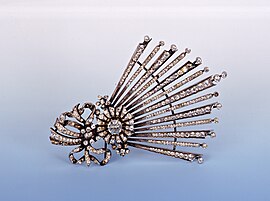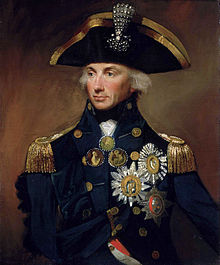Award
| Chelengk of the Ottoman Empire | |
|---|---|
 Replica of Lord Nelson's diamond chelengk Replica of Lord Nelson's diamond chelengk | |
| Type | Jewellery |
| Awarded for | Outstanding services to the state |
| Country | Ottoman Empire |
| Presented by | Ottoman Sultan |
| Eligibility | Civilians and military |
| Status | No longer awarded |
| Established | 1798 |
| Precedence | |
| Next (higher) | Order of Osmanieh |
| Next (lower) | Gallipoli Star |
A chelengk (Ottoman Turkish: چـلنك; Turkish: çelenk, pronounced [tʃeˈlæɲc]) was a military decoration of the Ottoman Empire.
Turkish military award
Originally a çelenk was "a bird's feather which one attaches to the turban as a sign of bravery" but by the end of the 18th century, the çelenk had become institutionalized in Ottoman military practice and continued to be awarded for military merit up to the 1820s. It was a jewelled aigrette consisting of a central flower with leaves and buds, and upward-facing rays.
In modern Turkish, a çelenk is a wreath or garland, a circular decoration made from flowers and leaves, usually arranged as an ornament.
Gifts to non-Turkish naval heroes

A specially-made chelengk was awarded to Horatio Nelson by Sultan Selim III in honour of the Battle of the Nile in 1798. This was the first time that a chelengk was conferred on a non-Ottoman. The usual seven rays were augmented to thirteen, as described in a contemporary letter:
The Aigrette is a kind of feather; it represents a hand with thirteen fingers, which are of diamonds, and allusive to the thirteen ships taken and destroyed at Alexandria, the size that of a child's hand about six years old when opened; the center diamond and the four round it may be worth about £1000 each, and there are about 300 others well set.
Nelson's chelengk was bought by the Society for Nautical Research in 1929 following a national appeal and placed in the National Maritime Museum. It was stolen in 1951 by Taters Chatham and never recovered.
Selim III also gave a chelengk to Russian Admiral Fyodor Ushakov after the capture of Corfu from the French in 1799.
In media
Literature
In Patrick O'Brian's Aubrey-Maturin series of novels, Captain Jack Aubrey is awarded a chelengk by the Sultan after capturing two rebel ships in The Ionian Mission. His chelengk was worn, like his hero Nelson's, on his dress uniform hat and contained hidden clockwork, so that the diamond strands shimmered in the sun.
Television and film
In season four, episode 4 of Miss Scarlet and The Duke, "The Diamond Feather," Admiral Nelson's chelengk is the subject of a fictional theft.
See also
References
- "Osmanlica Lûgât" [Ottoman Glossary] (in Turkish). Archived from the original on 5 September 2014. Retrieved 11 November 2012.
- Abel Pavet de Courteille; Mahdī Khān Astarābādī & Muḥammed Khuweyyi (1870). Dictionnaire Turk-Oriental. Paris: Imprimerie impériale.
Plume d'oiseau qu'on attache sur le bonnet en signe de vaillance
- ^ "Ottoman Orders and Decorations as Forms of Honor". Ottoman Bank Archives and Research Centre. Archived from the original on 1 May 2012.
- James Stanier Clarke; Stephen Jones; John Jones, eds. (1799). The Naval chronicle. Vol. 1. J. Gold. p. 340.
- "The Chelengk of Nelson – Proposed Purchase for the Nation". The Times. London. 8 November 1929. p. 10 (with photograph).
- "The Chelengk". The Art Fund. Archived from the original on 5 September 2014. Retrieved 11 November 2012.
- Patrick O'Brian (2003). Treason's Harbour. HarperCollins. p. 7. ISBN 0-00-649923-6.
Sources
- Roy Adkins & Lesley Adkins (2007). The War for All Oceans: From Nelson at the Nile to Napoleon at Waterloo. Abacus. p. 38. ISBN 978-0-349-11916-8.
- "Replica of Nelson's chelengk". National Maritime Museum.